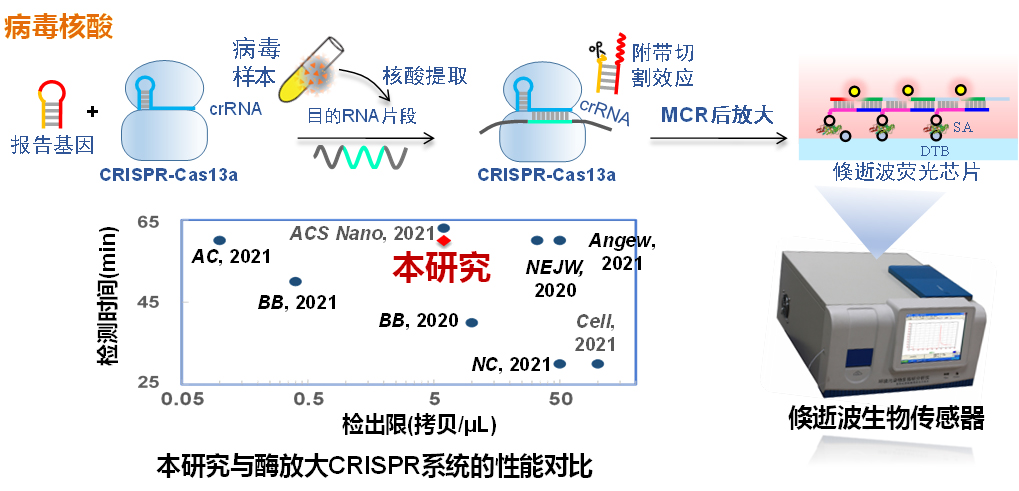Since the implementation of the Major Project of National Science Foundation of China “Environmental Safety and Secondary Risk Prevention and Control in Major Epidemics” led by the School of Environment, the research team of Project 1“Virus Detection and Their Transmission Mechanism in Environmental Media” has made progress in the biosensing detection of nucleic acid of coronavirus in environmental media. The team has developed a new strategy for nucleic acid sensing analysis by using CRISPR-Cas13a incidental cleavage products to trigger a low-cost enzyme-free hybridization chain reaction for signal amplification, and developed an evanescent wave fluorescence biosensing technology for rapid detection of coronavirus nucleic acid on site.

CRISPR Combined with Enzyme-free Post-amplification for Coronavirus Nucleic Acid Biosensing Analysis
Rapid and accurate quantitative detection of coronavirus is a prerequisite for achieving scientific prevention and control of pandemic outbreak, and a methodological basis for studying its transmission and interruption in environmental media. As a powerful complement to laboratory methods, the rapid on-site detection of viral nucleic acids has significant advantages in meeting the needs for routine surveillance of virus-like pathogenic microorganisms rather than depend on large laboratory instruments due to rapid response, simple method and low detection cost. By proposing a new strategy for viral nucleic acid sensing analysis with CRISPR-Cas13a incidental cleavage products triggering low-cost enzyme-free hybridization chain reaction for signal amplification, the team has developed an evanescent wave fluorescence biosensing technology for rapid on-site detection of coronavirus nucleic acids. By rationally designing three crRNAs, specific and broad-spectrum recognition of SARS-CoV-2, SARS-CoV and MERS-CoV was achieved, and the detection limits were comparable to those of enzyme-amplified CRISPR systems. The detection in negative pharyngeal swab extracts labeled with different concentrations of S-gene nucleic acid fragments showed a significant difference in fluorescence signal intensity compared to the control, validating the applicability of the technique in complex matrices. In addition, the fiber interface used in the evanescent wave fluorescence biosensor developed by the team can be regenerated using washing buffer that could be used repeatedly, with a signal drop of less than 2.5% after 100 repeated uses, indicating that the modified fiber has good regenerative stability. The method is rapid (<1 hour), easy to implement, accurate, and low-cost, providing technical support for the rapid detection of coronavirus on site.
This research was published in Biosensors and Bioelectronics titled “A CRISPR-based and post-amplification coupled SARS-CoV-2 detection with a portable evanescent wave biosensor”. The first author of the paper is Yang Yihan, a 2019 doctoral student in the School of Environment. And the lead of the project “Virus Recognition and Propagation Patterns in Environmental Media”, Associate Professor Zhou Xiaohong from the School of Environment, is the corresponding author of the paper. After being published, the paper has been listed as an ESI highly cited article.
The link of the paper: https://www.sciencedirect.com/science/article/pii/S0956566321004553?via%3Dihub





